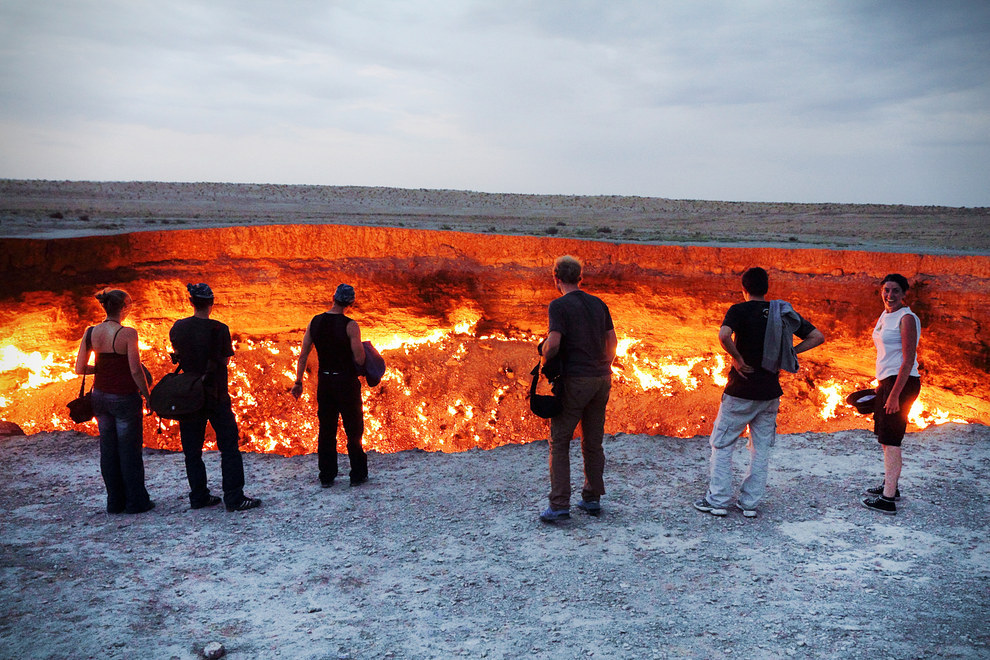1. “The Door to Hell” in Derweze, Turkmenistan


adventurous-travels.com

George Verschoor / Via National Geographic Channels
The Darvaza Crater, also known as “The Door to Hell,” in Derweze, Turkmenistan, has been burning since it was first discovered by Soviet engineers drilling for natural gas in 1971. When the ground below their drilling rig gave way, the engineers feared the release of poisonous fumes in the environment, so the decision was made to burn off the gas. The fire was thought to burn out after several weeks, but has been burning strong for over four decades now.
2. “The Troll’s Tongue” in Hordaland, Norway


Patrick Gensel / Via Flickr: patrickgensel

Via Flickr: pasto64
Trolltunga, or Troll’s Tongue, is located 2,300 feet above Lake Ringedalsvatnet in Norway. The rock formation was created during the ice age some 10,000 years ago when a glacier broke off large portions of the mountain and carried them away.
3. “The Stairway to Heaven” in Oahu, Hawaii


Shawn Clover / Via Flickr: shawnclover

Shawn Clover / Via Flickr: shawnclover
The Haiku Stairs, also known as the “Stairway to Heaven,” were built in the early 1940s as part of an American communications network during World War II. Despite being off limits to the general public, hikers have continued to climb its rusty steps for its breathtaking views of Oahu. It was reported that a recent storm had caused significant damage to the stairway, leaving it forever unusable.
4. “The Devil’s Pool,” bordering Zimbabwe and Zambia in Africa


dailymail.co.uk

Sarah Depper / Via Flickr: sarahdepper
When the waters of Victoria Falls at the border of Zambia and Zimbabwe reach a certain level, adventurous tourists are allowed to take a dip in the “The Devils Pool,” despite the risk of falling 355 feet to their deaths below.
5. The Cliffs of Moher, Ireland


Fedevphoto / Getty Images

Thinkstock
The Cliffs of Moher are located in County Clare, Ireland, rising up to 702 feet above the Atlantic Ocean at Hag’s Head. The site is one of Ireland’s most iconic tourist attractions and can easily be enjoyed without driving a mountain bike off the cliff.
6. Mendenhall Ice Caves in Juneau, Alaska


russgamer / Via Imgur.com

Terence Leezy / Via terenceleezy.com
The Mendenhall Ice Caves are located within the Mendenhall Glacier, a 12-mile-long glacier in the Mendenhall Valley, and are reachable only by kayak. Unfortunately, the Juneau Icefield Research Program has reported the glacier to have receded almost 2 miles since 1958 due to global warming.
7. The Kjeragbolten boulder in Rogaland, Norway


tothtamas.tt

slate.com
Located in the Kjerag mountain of Rogaland, Norway, the Kjeragbolten boulder is a popular tourist destination suspended 984 meters above the ground below. The boulder is so popular that it’s not uncommon to find yourself waiting in line for hours before ever stepping on this death defying photo-op.
8. The “Swing at the End of the World” in Baños, Ecuador


Jeremy Jauncey / Via Flickr: hinyer

Stefanos Antoniadis / Via Flickr: stefanosantoniadis
What looks to be a child’s treehouse is actually a seismic monitoring station positioned to watch over the nearby volcano, Mount Tungurahua. It’s there that a dangling rope swing offers tourists an opportunity to swing up and over the frightening canyon below.
9. Neptune Islands, Australia


Pink Scuba Tank / Via pinktankscuba.com

Thinkstock
Since 2002, The Neptune Islands is the only location in Australia in which shark cage diving is legally permitted. The waters surrounding the islands offer visitors a chance to get up close and personal with great white sharks. Just make sure to keep your arms and legs inside the cage.
10. The blood-red Lake Tuz in Aksaray, Turkey


Anadolu Agency / Getty Images

Anadolu Agency / Getty Images
Dunaliella Salinas, a type of halophile micro-algae, has been know to turn Turkey’s second largest lake blood-red. What’s even more spectacular about the lake is also that it’s home to a flock of wild flamingos!
11. “Death Road” in the Yungas region of Bolivia


Nick Smith / Guzelilian

armaanateeq.blogspot.com
The North Yungas Road, also known as the “Death Road,” has been dubbed by many as the world’s deadliest road, with an estimated 200 to 300 deaths each year. According to the BBC, in just one year some 25 vehicles careened off the road and into the canyon below. That’s roughly one vehicle every two weeks.
12. Mount Hua Shan in in Huayin, China


ahycenko.blogspot.com

masterok.livejournal.com
The trails up Mount Hua Shan are some of the most dangerous in the world and involve impossibly steep staircases, wooden platforms pinned to the sides of cliffs, and vertical drops that’ll make your stomach sink. The most popular route up the mountain was built in the 3rd to 4th century A.D. during the Tang Dynasty.
13. The Hang Son Doong cave in Quang Binh Province, Vietnam


meteoweb.eu

Dong Phuong Le Nguyen / Via Flickr: plsgvn
The Sơn Đoòng Cave is literally the world’s largest cave and was only discovered in 1991. Nuff said.
14. Ellison’s Cave in Georgia, United States


Flickr: wrcochran

Flickr: wrcochran
Ellison’s Cave is over 12 miles long and extends 1,063 feet vertically, which is a pretty huge drop into absolute darkness.
15. “The King’s Little Pathway” near Ardales, Spain


Thinkstock

Thinkstock
El Caminito del Rey, or “The King’s Little Pathway” in English, is a narrow walkway pinned to the wall of a gorge in southern Spain. It was first used as a walkway for hydroelectric power plant workers in the area and was given its name in 1921 after King Alfonso XIII crossed the walkway for the inauguration of the dam Conde del Guadalhorce.











RSS